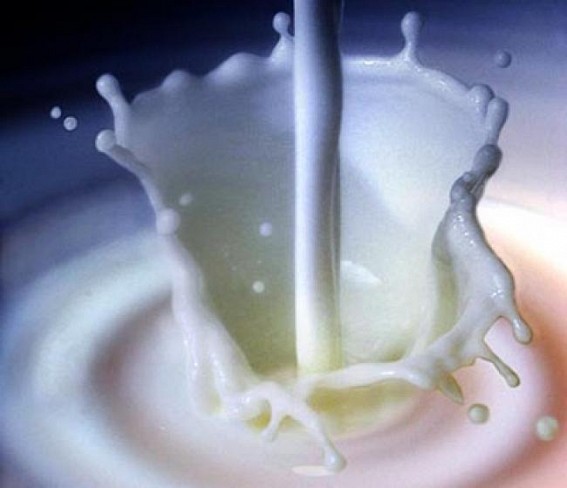Prof. (Dr.) Dharmeswar Das, Director, ARDD, Govt. of Tripura

PHOTO : TIWN
Milk from ruminant animals is an important component of the human diet. Animals have the unique ability to take organic material that is indigestible to humans and convert it into milk, a food with high nutritional value. Ancient civilizations learnt to exploit this potential through the domestication of various species of ruminants (having four chambers in stomach) including the cow, sheep, goat, buffalo, and camel.
It is a fact that some nutrients in foods have an effect greater than their nutritional value. Conjugated linoleic acids (CLA) are an example. CLA is a naturally occurring fatty acid in milk with a wide range of health benefits that prevents cancer and heart disease, regulates metabolism and works as anti-obesity. Milk and milk products are the major source of CLA in people’s diets which could be a boon to the dairy industry. If the dairy industry can capitalize on CLA’s presence in its products, consumers will have more reason than ever to include nature’s “health kick” in their diets.
Since Conjugated linoleic acid is a product of ruminant animals, bovine milk and milk products are among the richest dietary sources. CLA is formed in the rumen as an intermediate product in the digestion of dietary fat. The forages and grains fed to dairy cows are characterized by a relatively high content of linoleic (18:2) and linolenic (18:3) acid. The term conjugated linoleic acid refers to this whole group of 18 carbon conjugated fatty acids. Milk and meat from ruminants contains more CLA than that of non-ruminants. The amount of CLA found in whole milk is generally about 4.5 to 5.5 mg/g fat, although variation of as much as 2.5 to 18 mg/g fat has been reported.
More recently, particular emphasis has been given to feeding regimens in animals that will increase the concentration of CLA, a powerful anticarcinogen found naturally in ruminant milk fat. A cow's diet can have a major impact on CLA levels in her milk. The levels of CLA are found to be highest in milk from grazing cows and cows that had soybean oil added to their diet. The level increases as much as fivefold in cows eating only grass. However, to keep up milk production, dairy cows need to have supplemental feed, which decreases the amount of grass consumed and the content of CLA in milk. Even so, cows receiving two-thirds of their diet from green fodders and one-third from grain supplement still had a two to threefold increase of CLA in their milk.
Linolenic acid, the primary fatty acid in grass, is a precursor to the production of CLA in the rumen. It could be that grazing cows have different microbes in their rumen than cows fed a total mixed ration, and the different microbes might be responsible for the higher levels of CLA, There are, however, individual and breed variation exists in production level of CLA by cows. Age of the dairy cow and stage of lactation may also influence the milk CLA content to some extent. In view of the potential benefits of CLA for human health, a number of researchers began looking at possible ways of increasing the concentration of CLA in bovine milk fat. There appears to be two practical approaches to achieve this goal. The first approach is to use dietary modification in an attempt to increase the natural production of CLA in the cow. The second approach is to feed the synthetic mixture of CLA isomers, protected in some way from the microbial biohydrogenation in the rumen. While the grazing group averaged a four to fivefold increase, some individuals in the group had six to sevenfold increase. These results are optimistic for increasing CLA in milk to a level that may affect human health. Therefore, people might be able to consume higher levels of CLA through milk, butter, cheese, beef and lamb as scientists learn how to increase levels of CLA by improving ruminant diets.
The CLA content of dairy and meat products is altered little by processing, storage, or cooking and hence, the concentration in food depends primarily on the concentration in the raw material. Today consumers are becoming more conscious of the health attributes of the food they consume. CLA enriched milk may also be attractive to those who have abandoned milk and milk products, such as butter, due to concerns over the impact of milk fat on their health. The incentive for producers to feed the special supplement needed to enhance CLA levels would be the payment of a premium price for the milk. The concept of enhancing the levels of health promoting fatty acids in food is not new. A good example of this has been the introduction of eggs enriched in Omega-3 fatty acids. This recognizes the trend among consumers towards an increased desire to make diet choices that promote good health. The potent health promoting effects of CLA has been an unanticipated discovery. Enriching the level of CLA and other potentially beneficial fatty acids in dairy products may provide new market opportunities for milk and milk products.
To send your appreciation and comments pl. post it online below or send email to editor@tripurainfoway.com or tripurainfoway@gmail.com
- Why Modi’s BJP swept key India regional elections
- TIWN’s landmark legal victory against BJP Govt’s Illegal attacks to shutdown fearless Media
- India to be world's third-largest economy by 2030 -S&P Global Ratings
- Tripura's Dark Era : Mafia style Brutal attacks on Journalists, fight for your Citizen rights !
- How to access tripurainfoway.com via HOLA from India



